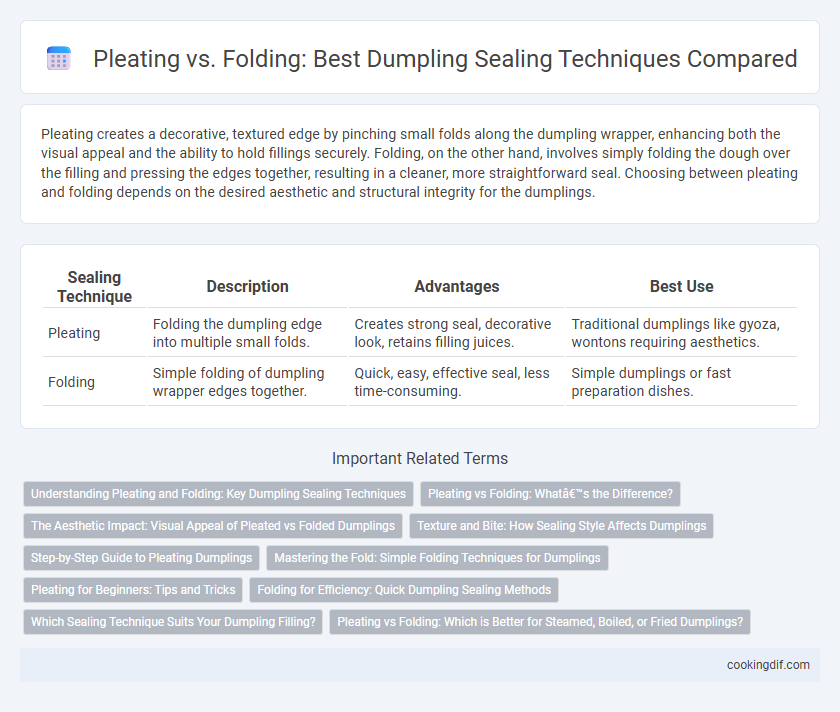Pleating creates a decorative, textured edge by pinching small folds along the dumpling wrapper, enhancing both the visual appeal and the ability to hold fillings securely. Folding, on the other hand, involves simply folding the dough over the filling and pressing the edges together, resulting in a cleaner, more straightforward seal. Choosing between pleating and folding depends on the desired aesthetic and structural integrity for the dumplings.
Table of Comparison
| Sealing Technique | Description | Advantages | Best Use |
|---|---|---|---|
| Pleating | Folding the dumpling edge into multiple small folds. | Creates strong seal, decorative look, retains filling juices. | Traditional dumplings like gyoza, wontons requiring aesthetics. |
| Folding | Simple folding of dumpling wrapper edges together. | Quick, easy, effective seal, less time-consuming. | Simple dumplings or fast preparation dishes. |
Understanding Pleating and Folding: Key Dumpling Sealing Techniques
Pleating and folding are essential dumpling sealing techniques that ensure a tight, leak-proof seal while enhancing the dumpling's texture and appearance. Pleating involves creating small, uniform folds along the edge of the dough, which provides extra reinforcement and an attractive, ruffled look. Folding, by contrast, typically means folding the dough in half and pressing the edges firmly together, offering a simpler yet effective seal ideal for thicker dough varieties.
Pleating vs Folding: What’s the Difference?
Pleating involves creating small, decorative folds along the edge of the dumpling wrapper, which not only enhances the appearance but also ensures a secure seal by compressing the dough tightly. Folding, in contrast, is a simpler method where the wrapper edges are pressed together without intricate patterns, offering a quicker but less decorative seal. Pleating generally provides better structural integrity for dumplings that are steamed or boiled, while folding works well for pan-fried or quick-cook dumplings.
The Aesthetic Impact: Visual Appeal of Pleated vs Folded Dumplings
Pleating dumplings creates a textured, intricate edge that enhances visual appeal with its delicate, fan-like patterns, making each piece appear handcrafted and artisanal. Folded dumplings offer a simpler, smoother seam that emphasizes uniformity and elegance, often highlighting the dumpling's plump filling beneath a clean, streamlined crust. Both techniques influence presentation; pleated dumplings stand out on serving platters with their decorative flair, while folded dumplings convey a minimalist sophistication favored in fine dining settings.
Texture and Bite: How Sealing Style Affects Dumplings
Pleating dumplings creates multiple layers, resulting in a chewier texture and a more complex bite, while folding produces a smoother, more uniform edge that enhances tenderness. The intricate pleats trap steam differently, giving each bite a slight resistance before revealing the filling, which elevates the overall mouthfeel. Folding offers a consistent seal that maintains dumpling integrity, providing a balanced combination of softness and firmness in every bite.
Step-by-Step Guide to Pleating Dumplings
Pleating dumplings involves creating multiple small folds along the edge of the wrapper to securely seal the filling, enhancing both appearance and texture. Start by placing a small spoonful of filling in the center of the wrapper, then moisten the edges with water before pinching and folding the dough, forming 6 to 8 intricate pleats on one side while keeping the other side flat. This method prevents leakage during cooking and adds a decorative, professional finish to traditional Chinese dumplings.
Mastering the Fold: Simple Folding Techniques for Dumplings
Mastering the fold involves using simple folding techniques that create tight seals and attractive shapes for dumplings. Pleating adds decorative ridges and extra security to prevent filling leakage, while folding focuses on swift, clean edges for a minimalist look. Practicing consistent folds ensures even cooking and a professional finish for every dumpling.
Pleating for Beginners: Tips and Tricks
Pleating is a popular dumpling sealing technique that creates a decorative, secure edge by folding small sections of the wrapper in repetitive, overlapping folds. Beginners should use a damp finger to moisten the edge of the wrapper, then carefully pinch and pleat, starting from one side and working evenly to the other, ensuring each pleat is uniform for a consistent seal. Mastering pleating improves dumpling appearance, prevents filling leakage, and enhances the overall cooking experience.
Folding for Efficiency: Quick Dumpling Sealing Methods
Folding techniques for dumpling sealing prioritize speed and efficiency by using simple, uniform creases that secure the filling without intricate pleats. This method reduces preparation time significantly, making it ideal for high-volume cooking or beginners mastering dumpling assembly. Quick folding ensures consistent sealing that prevents filling leakage while maintaining a neat appearance suitable for steamed, boiled, or pan-fried dumplings.
Which Sealing Technique Suits Your Dumpling Filling?
Pleating creates a textured seal that holds well with thicker, chunkier dumpling fillings like pork and vegetable mixes, ensuring the filling stays intact during steaming or frying. Folding provides a simpler, smooth edge ideal for delicate or watery fillings such as shrimp or tofu, reducing the risk of breakage. Selecting the sealing technique based on filling texture enhances durability and cooking results for your dumplings.
Pleating vs Folding: Which is Better for Steamed, Boiled, or Fried Dumplings?
Pleating creates a tight, decorative seal ideal for steamed dumplings, retaining moisture and preventing filling leakage during steaming. Folding offers a simpler, sturdier seal better suited for boiled or fried dumplings, where durability withstands boiling water or hot oil without breaking. Choosing pleating or folding depends on the cooking method and desired texture, with pleating preferred for delicate steamed dumplings and folding for robust boiled or fried varieties.
Pleating vs folding for dumpling sealing technique Infographic

 cookingdif.com
cookingdif.com